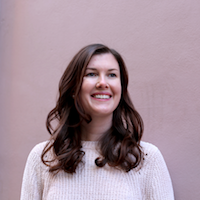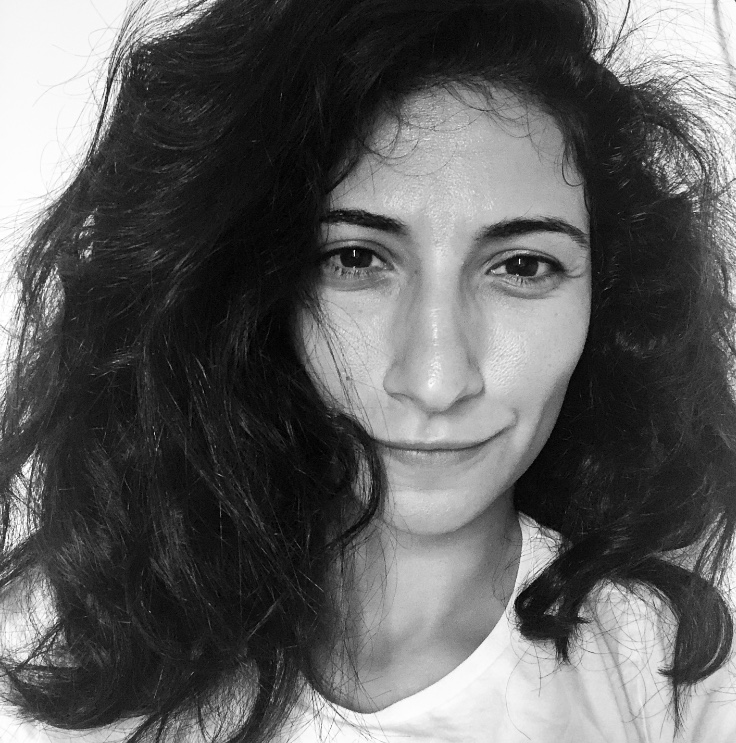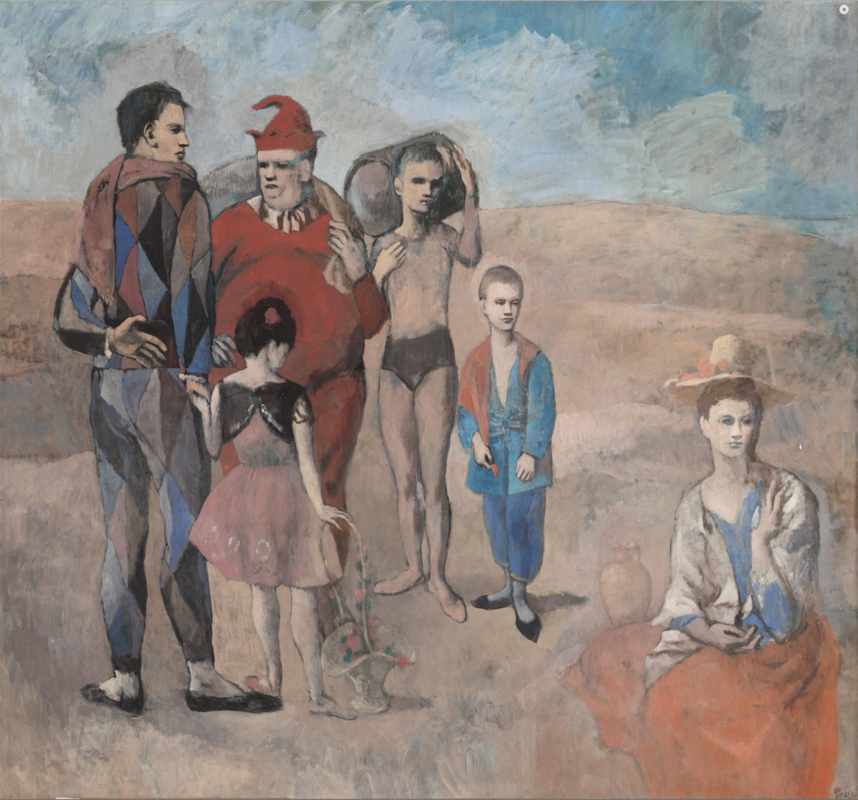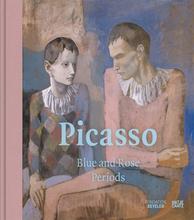More about Family of Saltimbanques
- All
- Info
- Shop

Contributor
Picasso’s Family of Saltimbanques is really three paintings for the price of one.
Imagine buying a Picasso painting only to discover years later that it’s actually not one, not two, but three Picasso paintings. Pretty sweet deal, if you ask me. Well, that’s sort of what happened with Family of Saltimbanques.
In 1980, the National Gallery of Art decided to celebrate Picasso’s 100th birthday with an exhibition featuring paintings from his circus phase (we all had one, right?). While doing some research on Family of Saltimbanques, they came across two different notes, one of which was from Fernande Olivier, Picasso’s main squeeze at the time, claiming that the canvas had been repainted several times. Intrigued by the comments, the NGA turned to SCIENCE (aka x-rays) and discovered that two long-lost paintings — Circus Family and Two Acrobats — had actually been painted over by Picasso himself. Gasp! Back then, Picasso was still broke so he often had to reuse canvases. But a watercolor study of Circus Family and studies for Two Acrobats had still existed, leaving scholars to wonder for decades WTF happened to them.
But the intrigue continues! Besides containing secret paintings, Family of Saltimbanques also contains a self-portrait of Picasso himself, disguised as the harlequin in the checkered getup. Picasso often used the harlequin as his alter ego in paintings because who wouldn’t want a wily trickster as their alter ego. Some experts think the lady rocking the straw hat is Olivier.
Picasso started painting circus scenes when he settled down in Paris in 1904. For a fun and crazy night out on the town, Picasso and his friends would go to shows put on by the local Cirque Médrano. Inspired by the performances, he painted a series of paintings featuring acrobats, clowns, musicians, and other circus figures. But as you can tell from the oh, so glum faces, Picasso wanted to show that the wandering performers were often isolated from the rest of society, something Picasso identified with at the time as a poor, struggling artist. Yet another reason why Picasso may have decided to paint himself as the harlequin.
Sources
- Paul Richard, “Lost Picasso Works Found Painted Over In National Gallery,” The Washington Post, October 14, 1980, https://www.washingtonpost.com/archive/lifestyle/1980/10/14/lost-picass…
- “Family of Saltimbanques,” National Gallery of Art, accessed on January 17, 2018, https://www.nga.gov/Collection/art-object-page.46665.html
- “Picasso The Early Years, 1892-1906,” National Gallery of Art, accessed on January 13, 2018, https://www.nga.gov/features/slideshows/picasso-the-early-years.html#sl…
- “Pablo Picasso,” Encyclopaedia Britannica, accessed on January 17, 2018, https://www.britannica.com/biography/Pablo-Picasso/Blue-Period#ref366489

Contributor
A circus came to town and you better believe Pablo Picasso sat front and center.
In December of 1904, Picasso frequently visited the Cirque Medrano with friends, including writers Andre Salmon and Guillaume Apollinaire. Here, Picasso sketched the costumes and amazing acrobatic feats of the circus performers. Forget about the popcorn and cotton candy, gimme my sketchbook!
Picasso’s buddies played an important role during this period of his life. Family of Saltimbanques was born out of Picasso’s Rose Period, named as such because of its warm hues (unlike the melancholic tones of the previous Blue Period). This was a happier time for Picasso, and it shows in the faces of the performers. It is speculated that the figures here are modeled on Picasso’s friends, who felt an affinity for the people of the circus, these nomadic and artistic outsiders. The poet Max Jacob appears in the boy in blue. The second performer, the shirtless one with the deep brow, resembles Andre Salmon, while the jester resembles Guillaume Apollinaire. To top the picture off, Picasso painted himself as the harlequin in the diamond-patterned suit.
Technology really does allow insight into the lives of our most beloved artists, as is the case in Family of Saltimbanques. Picasso hadn’t yet reached the stardom of his later life. Heck, he barely had money to afford new canvases. As a result, he was compelled to paint over the ones that wouldn’t sell. X-rays reveal that underneath this family of performers are two earlier paintings from the Rose Period. One of a different circus family, another of two acrobats.
Family of Saltimbanques ended up at the National Art Gallery in Washington, D.C. via the New York banker Chester Dale, who bought the painting for a whopping $100k back in 1931. But this painting has passed through many hands. Picasso originally sold it for 1,000 French francs to Andre Level, a lawyer and financier. Level then auctioned off the painting for 11,500 francs, passing it to Heinrich Thannhauser, who then sold the work to writer Herta Koenig. Finally, Chester purchased the work, and hung the painting in its current home in 1963.
Family of Saltimbanques even crossed paths with the poet Ranier Maria Rilke. In 1915 Rilke would gaze, starstruck, at Family of Saltimbanques every day. The painting would go on to be a key inspiration to Rilke’s Fifth Duino Elegy.
And this all started with a trip to the circus.
Sources
- Carmean Jr, E.A., Hoenigswald, Ann,“Picasso’s Hidden Figures,” Wall Street Journal, June 1, 2018. Accessed November 4, 2019. https://www.wsj.com/articles/picassos-hidden-figures-1527873163
- Langer, Emily, “E.A. Carmean Jr., National Gallery’s founding curator of 20th-century art, dies at 74,” Washington Post, October 19, 2019. Accessed November 12, 2019. https://www.washingtonpost.com/local/obituaries/ea-carmean-jr-national-…
- Press, Clayton, “Artful Art Investment: ‘The Skin of the Bear,’” Forbes, October 24, 2017. Accessed November 4, 2019. https://www.forbes.com/sites/claytonpress/2017/10/24/artful-art-investm…
- Reed, Peter, Picasso and Apollinaire: the Persistence of Memory, Berkley: University of California Press, 1995.
- Walther, Ingo F., Picasso, Cologne: Taschen, 2000.
Featured Content
Here is what Wikipedia says about Family of Saltimbanques
Family of Saltimbanques (French: Famille de saltimbanques) is a 1905 oil on canvas painting by Pablo Picasso. The work depicts six saltimbanques, a kind of itinerant circus performer, in a desolate landscape. It is considered the masterpiece of Picasso's Rose Period, sometimes called his circus period. The painting is housed in the collection of the National Gallery of Art in Washington, D.C.
Check out the full Wikipedia article about Family of Saltimbanques
















A Picasso I actually like. Color, composition, and a good write-up by Katie. Five stars...